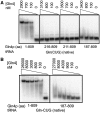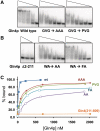Structural conservation of an ancient tRNA sensor in eukaryotic glutaminyl-tRNA synthetase
- PMID: 22180531
- PMCID: PMC3333875
- DOI: 10.1093/nar/gkr1223
Structural conservation of an ancient tRNA sensor in eukaryotic glutaminyl-tRNA synthetase
Abstract
In all organisms, aminoacyl tRNA synthetases covalently attach amino acids to their cognate tRNAs. Many eukaryotic tRNA synthetases have acquired appended domains, whose origin, structure and function are poorly understood. The N-terminal appended domain (NTD) of glutaminyl-tRNA synthetase (GlnRS) is intriguing since GlnRS is primarily a eukaryotic enzyme, whereas in other kingdoms Gln-tRNA(Gln) is primarily synthesized by first forming Glu-tRNA(Gln), followed by conversion to Gln-tRNA(Gln) by a tRNA-dependent amidotransferase. We report a functional and structural analysis of the NTD of Saccharomyces cerevisiae GlnRS, Gln4. Yeast mutants lacking the NTD exhibit growth defects, and Gln4 lacking the NTD has reduced complementarity for tRNA(Gln) and glutamine. The 187-amino acid Gln4 NTD, crystallized and solved at 2.3 Å resolution, consists of two subdomains, each exhibiting an extraordinary structural resemblance to adjacent tRNA specificity-determining domains in the GatB subunit of the GatCAB amidotransferase, which forms Gln-tRNA(Gln). These subdomains are connected by an apparent hinge comprised of conserved residues. Mutation of these amino acids produces Gln4 variants with reduced affinity for tRNA(Gln), consistent with a hinge-closing mechanism proposed for GatB recognition of tRNA. Our results suggest a possible origin and function of the NTD that would link the phylogenetically diverse mechanisms of Gln-tRNA(Gln) synthesis.
Figures





Similar articles
-
The structure of yeast glutaminyl-tRNA synthetase and modeling of its interaction with tRNA.J Mol Biol. 2013 Jul 24;425(14):2480-93. doi: 10.1016/j.jmb.2013.03.043. Epub 2013 Apr 10. J Mol Biol. 2013. PMID: 23583912 Free PMC article.
-
Deinococcus glutaminyl-tRNA synthetase is a chimer between proteins from an ancient and the modern pathways of aminoacyl-tRNA formation.Nucleic Acids Res. 2007;35(5):1421-31. doi: 10.1093/nar/gkl1164. Epub 2007 Feb 6. Nucleic Acids Res. 2007. PMID: 17284460 Free PMC article.
-
Coevolution of specificity determinants in eukaryotic glutamyl- and glutaminyl-tRNA synthetases.J Mol Biol. 2014 Oct 23;426(21):3619-33. doi: 10.1016/j.jmb.2014.08.006. Epub 2014 Aug 19. J Mol Biol. 2014. PMID: 25149203
-
Divergence of glutamate and glutamine aminoacylation pathways: providing the evolutionary rationale for mischarging.J Mol Evol. 1995 May;40(5):476-81. doi: 10.1007/BF00166615. J Mol Evol. 1995. PMID: 7783222 Review.
-
Glutaminyl-tRNA synthetase: from genetics to molecular recognition.Genes Cells. 1996 May;1(5):421-7. doi: 10.1046/j.1365-2443.1996.d01-255.x. Genes Cells. 1996. PMID: 9078373 Review.
Cited by
-
Modulating the Structure and Function of an Aminoacyl-tRNA Synthetase Cofactor by Biotinylation.J Biol Chem. 2016 Aug 12;291(33):17102-11. doi: 10.1074/jbc.M116.734343. Epub 2016 Jun 21. J Biol Chem. 2016. PMID: 27330079 Free PMC article.
-
The structure of yeast glutaminyl-tRNA synthetase and modeling of its interaction with tRNA.J Mol Biol. 2013 Jul 24;425(14):2480-93. doi: 10.1016/j.jmb.2013.03.043. Epub 2013 Apr 10. J Mol Biol. 2013. PMID: 23583912 Free PMC article.
-
Mutations in QARS, encoding glutaminyl-tRNA synthetase, cause progressive microcephaly, cerebral-cerebellar atrophy, and intractable seizures.Am J Hum Genet. 2014 Apr 3;94(4):547-58. doi: 10.1016/j.ajhg.2014.03.003. Epub 2014 Mar 20. Am J Hum Genet. 2014. PMID: 24656866 Free PMC article.
-
A new view on crystal harvesting.J Appl Crystallogr. 2014 May 29;47(Pt 3):1158-1161. doi: 10.1107/S1600576714008899. eCollection 2014 Jun 1. J Appl Crystallogr. 2014. PMID: 24904250 Free PMC article.
-
The crystal structure of human GlnRS provides basis for the development of neurological disorders.Nucleic Acids Res. 2016 Apr 20;44(7):3420-31. doi: 10.1093/nar/gkw082. Epub 2016 Feb 10. Nucleic Acids Res. 2016. PMID: 26869582 Free PMC article.
References
-
- Mirande M. Processivity of translation in the eukaryote cell: role of aminoacyl-tRNA synthetases. FEBS Lett. 2010;584:443–447. - PubMed
-
- Cusack S, Berthet-Colominas C, Hartlein M, Nassar N, Leberman R. A second class of synthetase structure revealed by X-ray analysis of Escherichia coli seryl-tRNA synthetase at 2.5 A. Nature. 1990;347:249–255. - PubMed
-
- Eriani G, Delarue M, Poch O, Gangloff J, Moras D. Partition of tRNA synthetases into two classes based on mutually exclusive sets of sequence motifs. Nature. 1990;347:203–206. - PubMed
Publication types
MeSH terms
Substances
Associated data
- Actions
Grants and funding
LinkOut - more resources
Full Text Sources
Molecular Biology Databases

